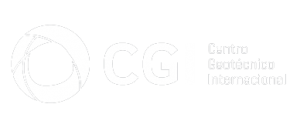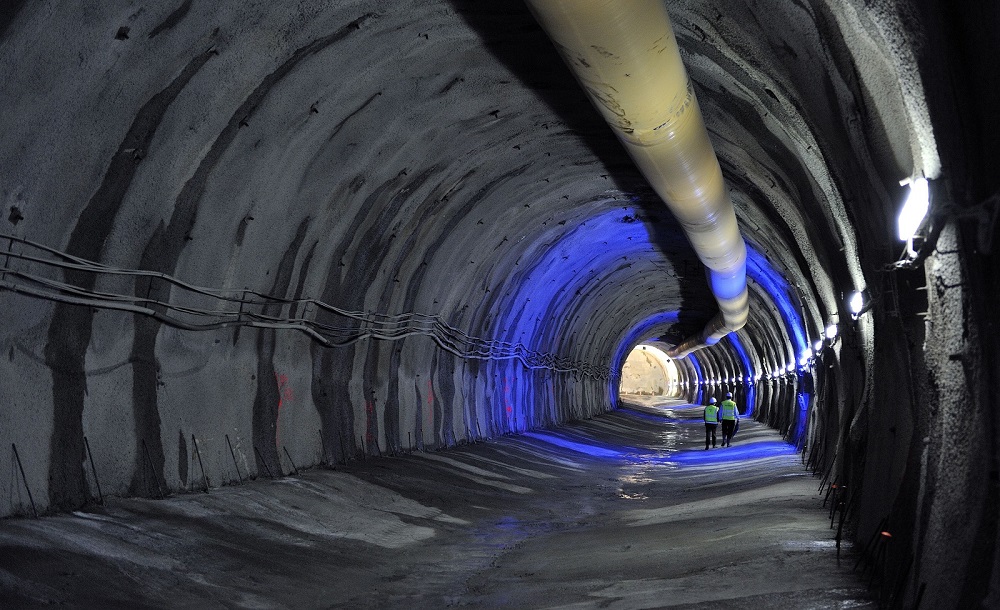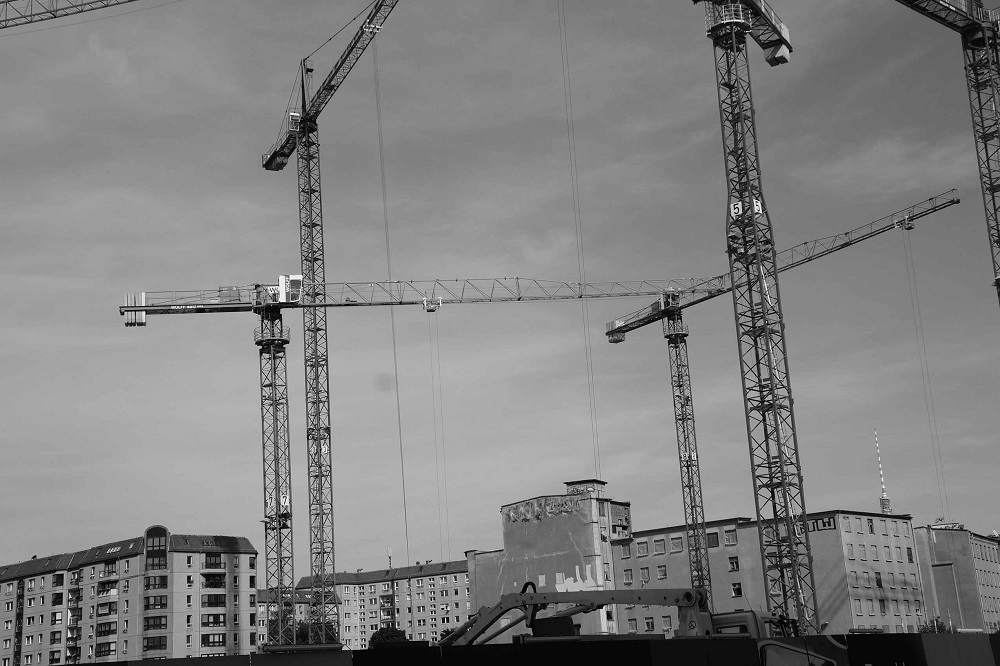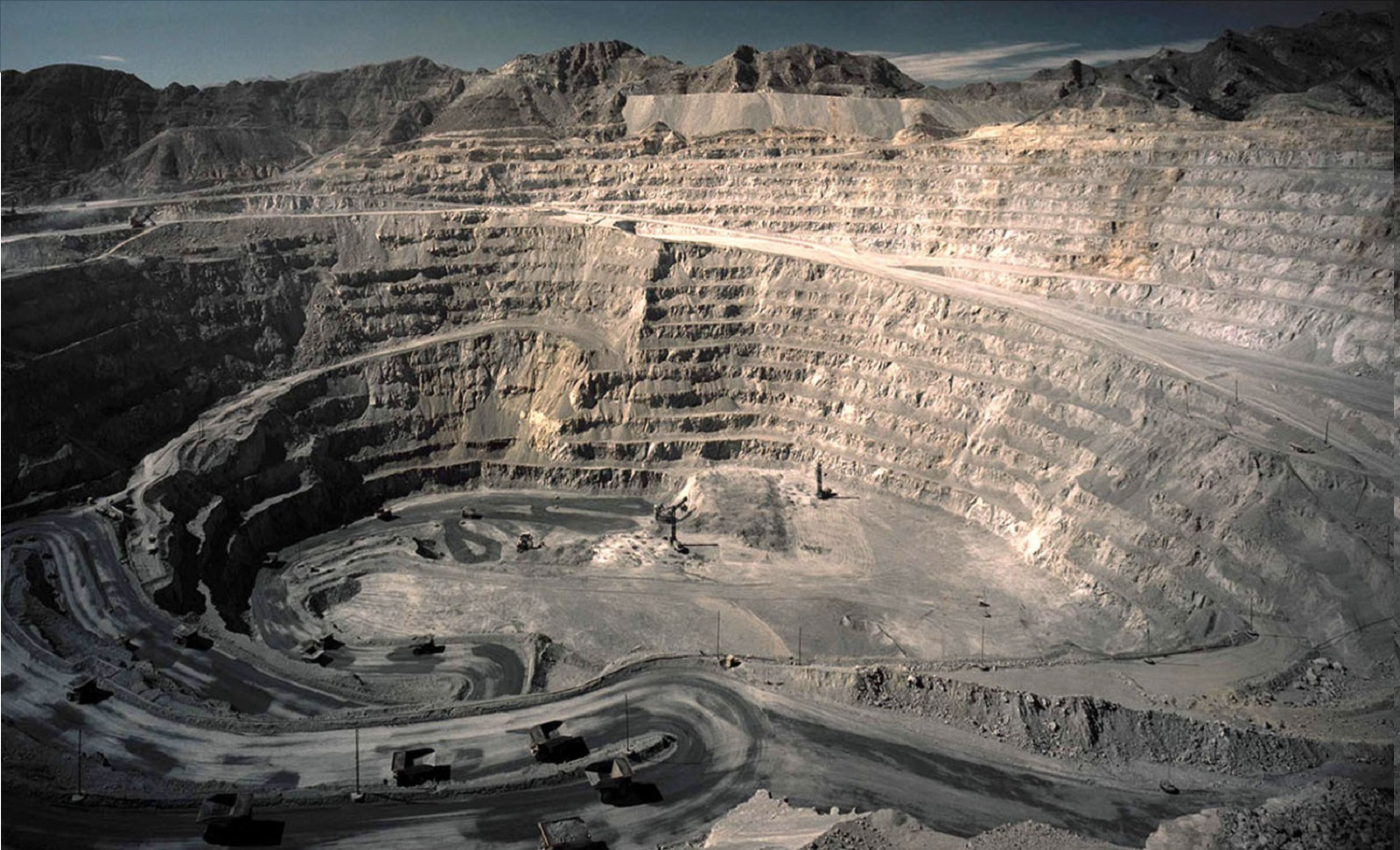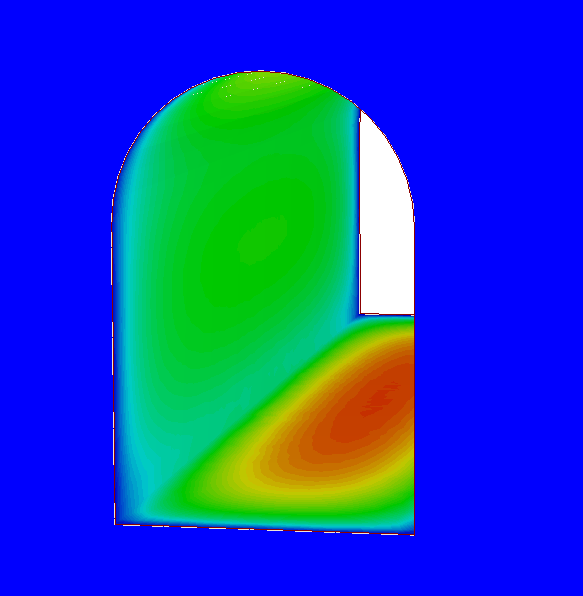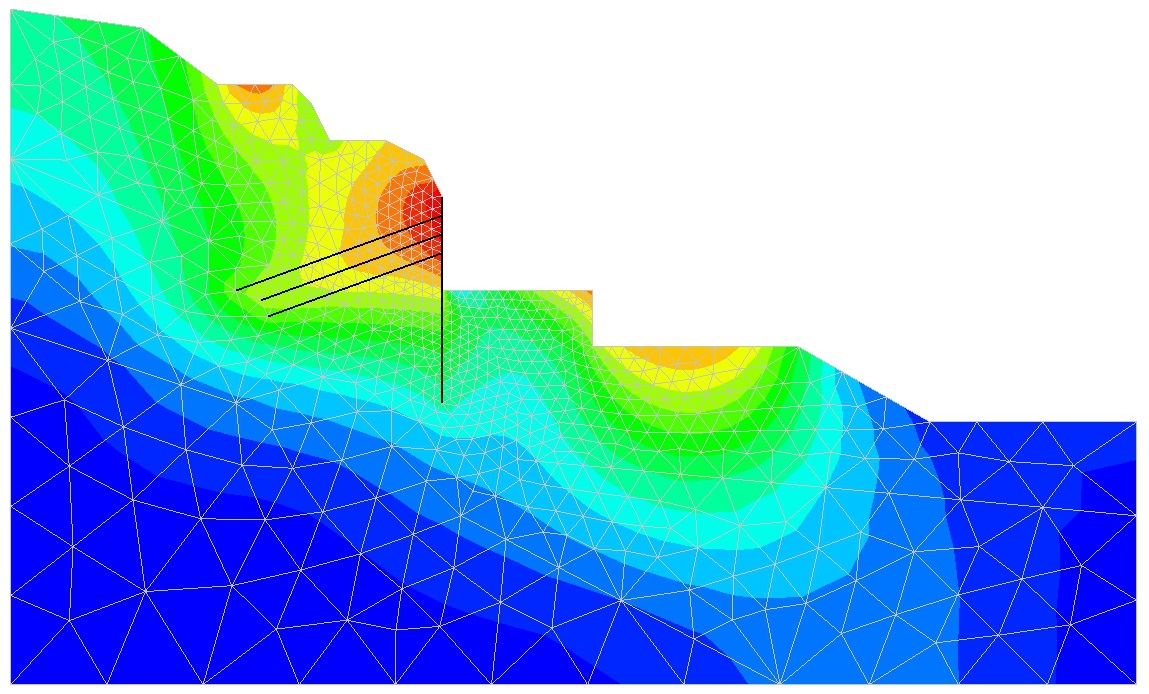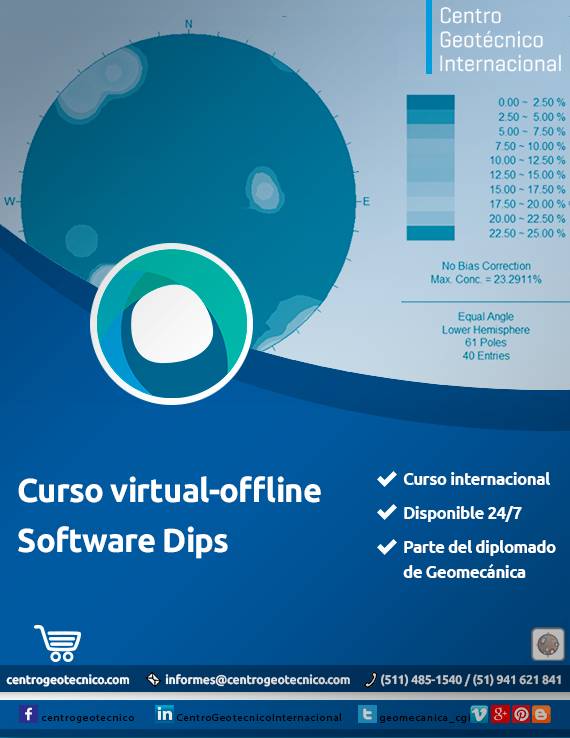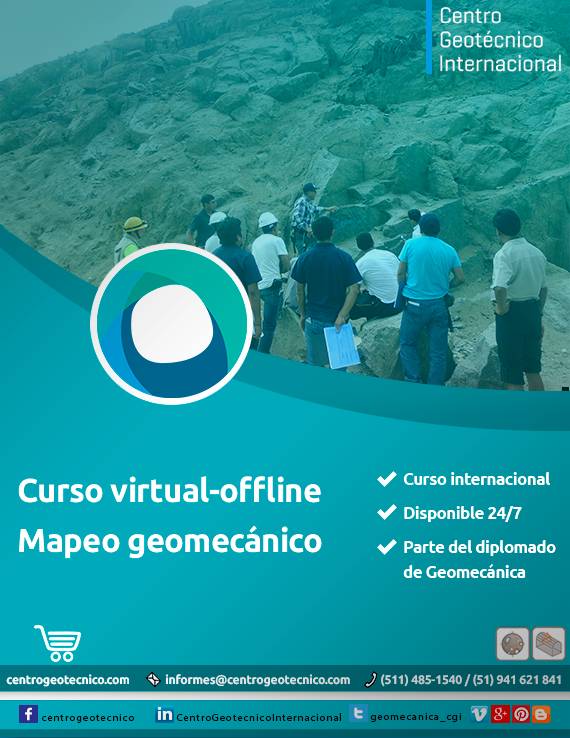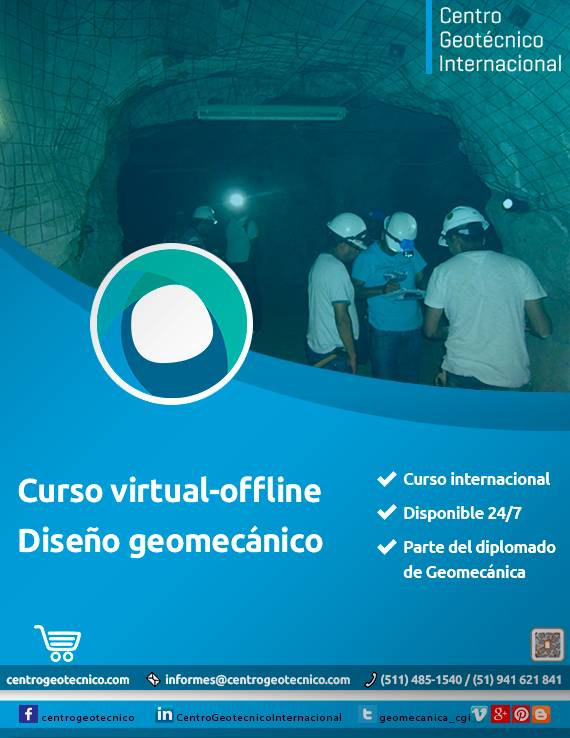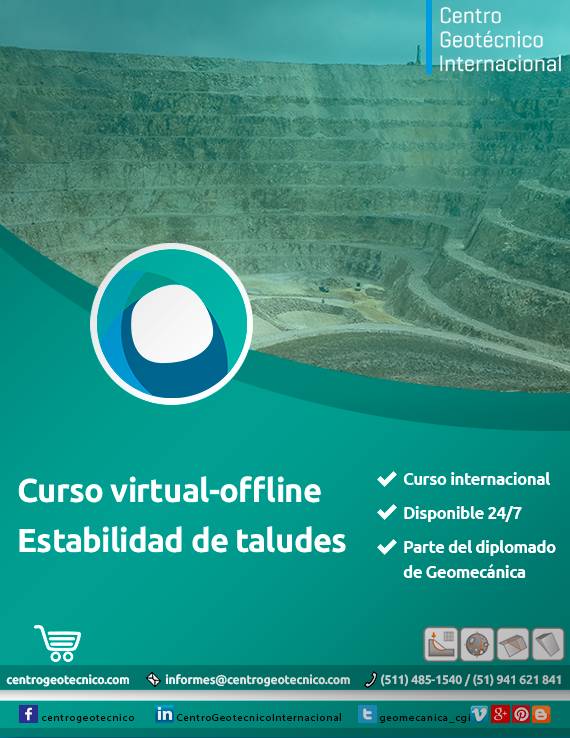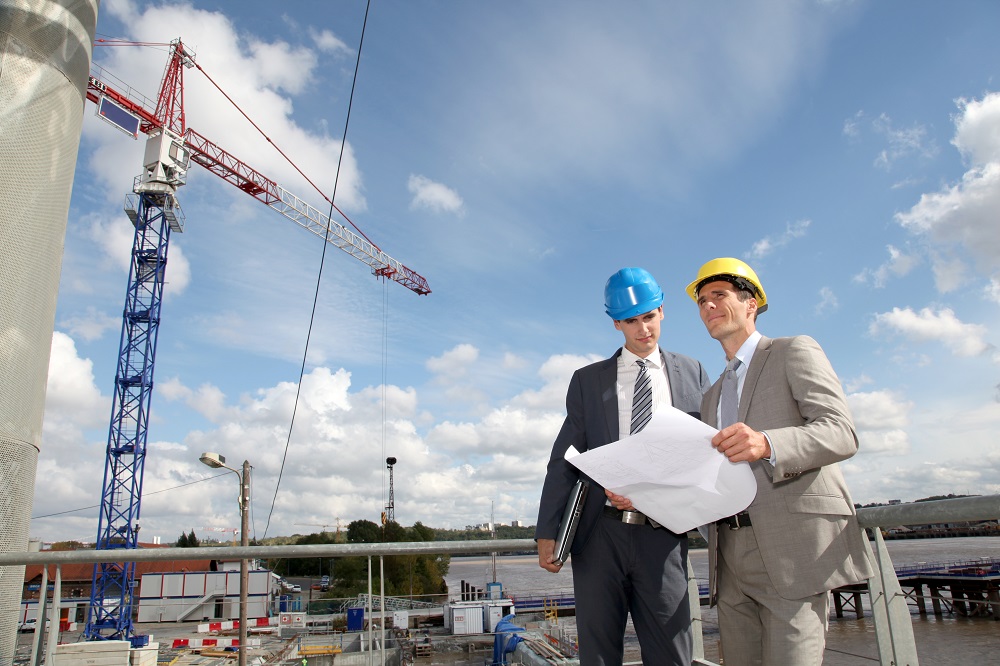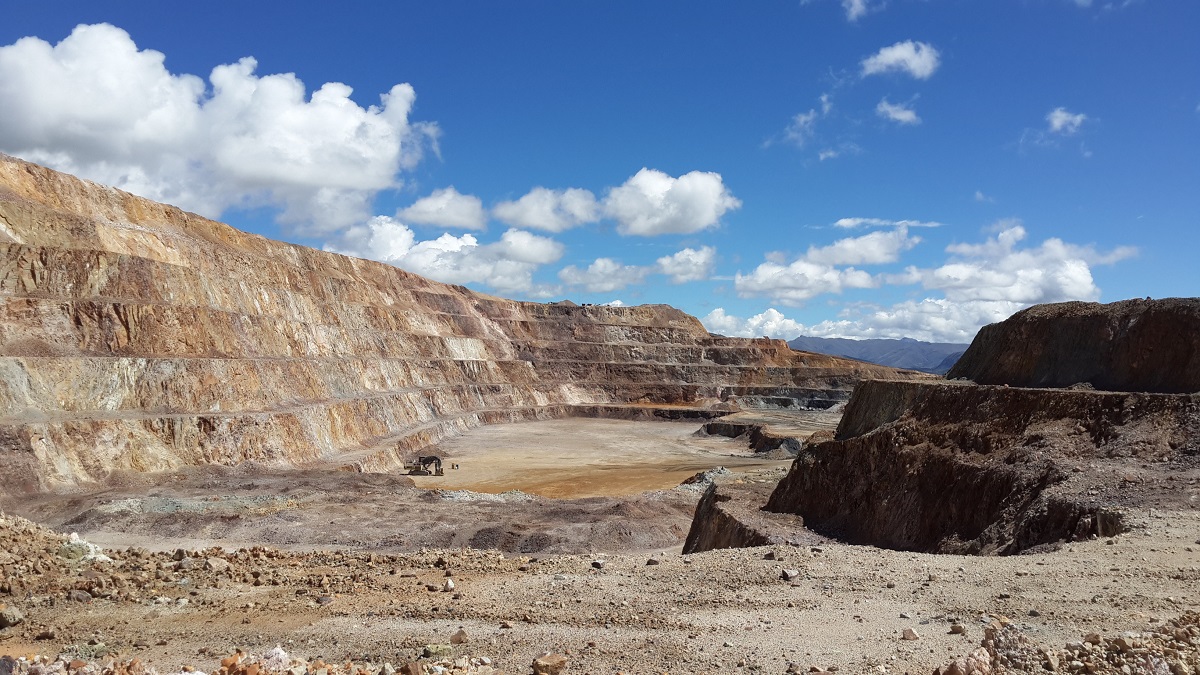Training modality
- 100% virtual offline modality (asynchronous, without class schedules, access 24 hours a day, all year round)
Duration
8 months
315 academic hours
Start date
You choose when to start your first module
AVAILABLE IN ALL COUNTRIES

Adequate characterization of the geological environment is essential when designing any type of structure. The design of a foundation, the stability of a slope, the excavation of a tunnel or the construction of a dam depend, in the first instance, on the behavior of the terrain and its interaction with the structure.
The fundamental objective of this diploma course is to establish in the student solid knowledge in geotechnics, which will allow them to approach the engineering of the project in a practical and realistic way. Through the study of terrain recognition techniques, the evaluation of its geotechnical parameters and the study of the different calculation methodologies and the most relevant geotechnical aspects, the necessary requirements are provided to propose the different construction solutions in an efficient way.
► Receive the certificates and diploma in the name of the International Geotechnical Center.
► Receive training from a speaker with extensive experience in the field.
► Receive materials for each module, such as slides, manuals, and data that you can keep.
► Access to view the class videos for the modules through the CGI Virtual Campus.
► Ability to make necessary academic inquiries through the CGI Virtual Campus forum.
► Access the modules from wherever you are through your computer and the Internet.
► You will have a privileged view of the classes compared to an in-person diploma program.
► Module 1: Introduction to geotechnical engineering, field reconnaissance and laboratory tests
1. Introduction to Geotechnical Engineering
1.1. The Geological Environment and Its Importance in Civil Engineering
1.2. The Geological Model and the Geotechnical Model
1.3. Geotechnical Investigation and Its Implication in the Project
1.4. Main Geotechnical Problems. Examples of Geotechnical Disasters.
2. Geotechnical Investigation Campaign; Field Reconnaissance and Laboratory Tests
2.1. Project Phases and Intensity of Investigation Campaign
2.2. Field Reconnaissance
2.2.1. Scope of Reconnaissance, Number, and Depth of Prospections
2.2.2. Sources of Information and Previous Studies.
2.2.3. Geological Mapping.
2.2.4. Geomechanical Stations and Geomechanical Classifications.
2.2.4.1. Schmidt Hammer and Point Load Test
2.2.5. In-Situ Investigations
2.2.5.1. Geophysical Survey
2.2.5.1.1. Seismic Methods
2.2.5.1.2. Electrical Methods
2.2.5.1.3. Electromagnetic Methods
2.2.5.1.4. Gravimetric and Magnetic Methods
2.2.5.1.5. Thermal Methods
2.2.5.2. Geotechnical Borings and In-Situ Tests
2.2.5.2.1. Geological-Geotechnical Logging
2.2.5.2.2. Standard Penetration Test, SPT.
2.2.5.2.3. Vane Shear Test
2.2.5.2.4. Pressuremeter and Dilatometer
2.2.5.2.5. Geophysical Tests; Downhole and Crosshole
2.2.5.2.6. Permeability Tests
2.2.5.2.7. Pumping Tests
2.2.5.3. Geotechnical Test Pits
2.2.5.4. Penetration Tests
2.2.5.4.1. Dynamic Penetration Tests
2.2.5.4.2. Static Penetration Tests
2.2.5.5. Tilt Test
2.2.5.6. Plate Load Test
2.2.5.7. Flat Jack Test
2.2.5.8. Sampling
2.2.5.8.1. Sample Collection
2.2.5.8.2. Type of Samples
► Module 2: Soil mechanics
1. Origin and Formation of Soils
2. Characterization and Classification of Soils
2.1. Types of Soil
2.2. Grain Size Distribution, Plasticity, and Soil State
2.3. Clayey Soils
3. Stresses in the Ground
3.1. Principle of Effective Stresses
3.2. Vertical Stresses
3.2.1. Stresses under Quiescent Water
3.2.2. Stresses under Flowing Water
3.2.2.1. Downward Flow
3.2.2.2. Siphoning
3.2.2.3. Capillarity
3.3. Horizontal Stresses
3.4. Stresses on a Plane. Mohr's Circle
4. Strength and Deformation of Soils
4.1. Failure Criteria, Mohr-Coulomb Model.
4.2. Cohesion and Angle of Friction
4.3. Shear Strength with and without Drainage.
4.4. Determination of Strength
4.4.1. Direct Shear Test
4.4.2. Triaxial Test
4.4.3. Unconfined Compression Test
5. Soil Consolidation
5.1. Consolidation Process and Overconsolidation.
5.2. Consolidation Theory
5.3. Edometric Test
5.4. Settlements
5.5. Consolidation Times
6. Problematic Soils
6.1. Expansive Soils
6.2. Collapsible Soils
6.3. Dispersive Soils
6.4. Liquefiable Soils
► Module 3: Rock Mechanics
1. INTRODUCTION TO ROCK MECHANICS
1.1. Introduction to Geotechnics: Derived Specialties and Fields of Application.
1.2. Geotechnics - Geomechanics - Rock Mechanics: Concepts & Definitions.
1.3. Principles of Basic & Applied Rock Mechanics
1.4. Definitions: Intact Rock, Discontinuities, and Rock Mass
1.5. Geological Environment: Rock Types and Effects of Alteration
1.6. Anisotropy and Homogeneity in Rocks
1.7. In situ Stresses & Induced Stresses
1.8. Water and Rock Mass (Permeability)
2. GEOMECHANICAL CHARACTERIZATION FOR ENGINEERING PURPOSES
2.1. Geomechanical Classifications
2.2. Characterization of Geological-Structural Discontinuities
2.3. Surface Mapping Techniques of Outcrops and Geomechanical Logging of Cores
2.4. Description of Geological Discontinuities: Geometric and Strength Properties.
2.5. Analysis, Processing, and Interpretation of Structural Discontinuity Data.
2.6. Introduction to Hemispherical Projections in Structural Geology.
2.7. Applications of Stereographic Projection in Rock Mechanics.
2.8. Uses of Wulff Net (Equal Angle) and Schmidt Net (Equal Area).
2.9. Review of Plane and Line Plotting in Stereography.
2.10. Orientation of Planes and Lines in Structural Geology.
2.11. Interpretation of Stereograms in Rock Geomechanics
2.12. Identification of Sets or Families of Discontinuities
3. INTRODUCTION TO ROCK LABORATORY TESTING
3.1. Introduction
3.1.1. ASTM Standards vs ISRM Procedures
3.1.2. Field Testing vs Laboratory Testing
3.1.3. Basic Testing vs Specialized Testing
3.1.4. Destructive Testing vs Non-Destructive Testing
3.1.5.Rock Testing vs Discontinuity Testing
3.2. Reception, Handling, and Preparation of Rock Samples
3.3. Determination of Index Properties of Intact Rock
3.3.1. Specific Gravity, Absorption, Porosity, Density
3.4. Testing of Intact Rock Strength
3.4.1. Direct ➔ Uniaxial Compressive Strength (UCS)
3.4.2. Indirect ➔ Point Load Test (PLT)
3.4.3. Triaxial Compression Strength of Rocks (TX)
3.4.4. Indirect Tensile Strength of Rocks (Brazilian Method)
3.5. Shear Strength on Discontinuity Surfaces
3.5.1. Natural Discontinuity vs Simulated Discontinuity
3.6 Determination of Elastic Constants
3.6.1. Young's Modulus
3.6.2. Poisson's Ratio
3.7. Analysis and Processing of Rock Laboratory Test Results.
4. ANALYSIS OF STABILITY OF SURFACE AND UNDERGROUND EXCAVATIONS IN MINING.
4.1. Stability of Mining Benches at Bench, Inter-ramp, and Overall Scale.
4.2. Calculation of Safety Factors and Probability of Slope Failure
4.3. Stress-Strain Analysis of Underground Rock Excavations
4.4. Definition of In-situ Stress Field and Generation of Induced Stresses
► Module 4: Foundations (shallow and deep) and containment structures
1. Concept and Criteria for Choosing the Type of Foundation
2. Shallow Foundations
2.1. Geotechnical Investigation
2.2. Definition
2.3. Types of Direct Foundations
2.4. Distribution of Stresses beneath the Ground
2.5. Ultimate Limit States. Checks.
2.6. Settlement Pressure and Allowable Pressure
2.6.1. Foundations on Granular Soils
2.6.2. Foundations on Cohesive Soils
2.6.3. Foundations on Rock
2.7. Settlements
2.7.1. Granular Soils
2.7.2. Cohesive Soils
2.8. Construction Conditions
3. Deep Foundations
3.1. Geotechnical Investigation
3.2. Definition
3.3. Types of Piles
3.4. Execution Procedures
3.5. Ultimate Limit States. Checks.
3.6. Settlement Load
3.6.1. Piles Embedded in Rock
3.6.2. Piles in Soils
3.6.3. Driven Piles
3.7. Negative Friction
3.8. Horizontal Thrusts
3.9. Structural Cap
3.10. Settlements
3.11. Micropiles and Anchors as Foundation Elements
3.12. Box Foundations
3.13. Construction Conditions
4. Foundations in Complex Geological Conditions
4.1. Expansive Soils
4.2. Collapsible Soils
4.3. Karstic Soils
4.4. Other Soils
5. Retaining Structures
5.1. Geotechnical Investigation
5.2. Types
5.3. Rigid Structures
5.3.1. Gravity Walls
5.3.2. Structural Walls
5.4. Rankine Theory
5.5. Active, Passive, and At-Rest Pressures.
5.6. Ground, Water, and Overload Pressures.
5.7. Ultimate Limit States. Checks.
5.8. Preliminary Design of Walls
5.9. Flexible Structures.
5.9.1. Screens
5.9.2. Shoring
5.9.3. Sheet Piles
► Module 5: Slope Stability in soils and rocks
1. Introduction to Slope Stability Analysis
1.1. Nomenclature of a Slope
1.2. Types of Slope Instabilities
1.3. Conditioning and Triggering Factors
1.4. Symptoms of Instability
2. Methods of Stability Analysis in Rocks
2.1. Plane Failure Analysis
2.2. Analysis on a Composite Surface
2.3. Analysis with Tension Crack
2.4. Analysis by Rotational Failure
2.5. Wedge Failure Analysis
2.6. Toppling Analysis
2.7. Rock Fall Analysis
3. Methods of Stability Analysis in Soils
3.1. Influence of Water and Seismic Forces on Slopes
3.2. Principles of Stability Analysis and Safety Factor
3.3. The Swedish Method
3.4. Taylor and Fellenius Approaches
3.5. Bishop, Spencer, and Janbu Method
3.6. Morgenstern and Price Procedure
3.7. Infinite Slope Method
4. Application of Software in Slope Stability Design and Analysis
4.1. Application of Dips, RocPlane, Swedge, RocTopple, and RockFall Software
4.2. Application of Slide2 Software
4.3. Comparisons with Limit Equilibrium Analysis
4.4. Design of Preventive Measures
► Module 6: Tunnels and underground excavations
1. Geological and Geotechnical Research and Characterization
1.1. Introduction and General Characteristics
1.2. Geological Characterization
1.3. Geotechnical Characterization
1.4. Structural Characterization
1.5. Hydrogeological Characterization
2. Modeling Elements for Conventional Tunnels
2.1. Laboratory Tests
2.2. Geomechanical Classifications Applied to Rock Mass Characterization
2.3. Excavation Behavior Classes
2.4. Excavation Size Selection and Fortification Calculation
2.5. Determination of Support Sizing Loads
3. Modeling Elements for Mechanized Tunneling Methods
3.1. Definition and Elements of Tunnel Boring Machines (TBM)
3.2. Risks and Damages Caused by Settlements
3.3. Ground Treatments
3.4. Prevention of Damages Due to Ground Settlements
3.5. Lining Rings: Classification and Design
4. Analytical Methods and Numerical Methods
4.1. Analytical Methods
4.2. Numerical Methods
4.3. Convergence-Confinement Method
4.4. Excavation Curve
4.5. Lining Curve
5. Numerical Modeling of Tunnels
5.1. RocData
5.2. Dips
5.3. RS2
5.4. Others
6. Tunnel Waterproofing Methods
6.1. Groundwater in Tunnels
6.2. Injection Methods
6.3. Soil Injection Methods - Rock Injection Methods
6.4. Waterproofing Methods Using Membranes
6.5. Waterproofing Effectiveness Analysis
7. Special Cases in Tunnel Construction
7.1. Tunnels with Anisotropy
7.2. Tunnels with Squeezing Problems
7.3. Tunnels with Swelling Problems
7.4. Tunnels with Stress Problems
8. Risk Management in Tunnels
8.1. Prevention and Control of Tunnel Construction Risks
8.2. Prevention and Control of Risks on Sites
8.3. Prevention and Control of Fires
8.4. Prevention and Control of Electrical Risks
8.5. Lighting
8.6. Ventilation
8.7. Prevention and Control of Risks in the Use of Explosives
► Module 7: Embankments (earth structures) and Dams
1. Embankments (Earth Structures)
1.1. Typology of Earth Structures
1.2. Design of Earth Structures
1.2.1. Zoning of Fill Material
1.2.2. Type of Fill Materials
1.2.2.1. PG3 Classification
1.2.2.2. UIC Classification
1.2.3. Material Testing
1.3. Construction of Embankments
1.3.1. Spreading, Moistening, and Compaction
1.3.2. Construction Control
1.4. Embankments on Soft Soils
1.5. Half-Slope Embankments
2. Dams
2.1. Typology of Dams
2.1.1. Loose Material Dams
2.1.2. Concrete Dams
2.2. Auxiliary Structures
2.3. Geotechnical Investigation Phases
2.4. Geotechnical Survey
2.5. Seismicity Studies
2.6. Geological Geotechnical Criteria for Dam Selection
2.6.1. Characterization of the Dam Site
2.6.2. Dam Seepage
2.6.3. Reservoir Sealing
2.6.4. Stability of Reservoir Slopes
2.6.5. Material Prospecting
2.6.5.1. Loose Material Dams
2.6.5.1.1. Core
2.6.5.1.2. Toe
2.6.5.1.3. Filters and Drains
2.6.5.1.4. Protections
2.6.5.2. Aggregates for Concrete
2.7. Dam Foundations
2.7.1. Solicitations
2.7.2. Ground Treatments
2.7.3. Failure Mechanisms
► Module 8: Hydrology and Applied Hydrology
1. Watershed and Hydrogeological Basin
2. Determination and Analysis of Regional Patterns of Groundwater Flow
3. Concepts for Hydrological Analysis and Analysis of Hydrometeorological Information
4. Methods for Estimating Discharge in Surface Water Features
5. Geophysical Methods and Groundwater
6. Wells, Piezometers, and Monitoring Networks
7. Chemical Hydrogeology
8. Elements for Local Hydrogeological Modeling
9. Environmental Hydrogeology
► Module 9: Thesis Project
* Definition of lines of research
* Advice and support in the development of the thesis
* Review of the theses
The modality presented is the “Virtual-OFFLINE” (Virtual asynchronous). At the end of each course, you must take an exam to pass it and move on to the next course.
You will be assigned the tutoring of a specialist and there will be no limitations in terms of access hours or consultations with the speaker, this promotes that you be trained efficiently. The hours dedicated to each module must be managed assertively to optimize the benefit. You will experience all of the above through our virtual campus, which will also allow us to monitor your progress.
Professionals and technicians who work in mining, construction and/or energy companies and are working in the areas of engineering, rock engineering, rock mechanics, planning, geotechnics, geomechanics, geology, mining safety and professionals who require greater knowledge her.
Likewise, professionals from mining contracting companies, infrastructure, consultants, university professors and students and the general public who are involved in the topic.
8 months. 315 academic hours are accredite
The Diploma is available at all times. The start date of the same will be based on your availability of time.
- Enrolled in different online courses
"I appreciate for the knowledge as it improves my knowledge for rock mechanics as applied in tunneling and open pits excavations. Best to acquire the knowledge regarding the rock mechanics for support and excavation in mining Works”
Thomas Joachim Lyaupe
Project geologist
Tanesco
TANZANIA

"The course was interesting and for me as a professional it can be implemented in my works. The course diploma that i had enroll right now is really added to my knowledge in mining geomechanics. The lecturer here is also very competent so what they teached us is understanable”
Arthur Gemas Pradhana Nayoan
Geologist - Exploration and Geotechnics
PT Billy Group Indonesia
INDONESIA

"I have just finished my first module of the course. I can say that this module was complet, I had a general concept of all the area involved in Rock Mechanics and could develop a basic and valuable knowledge of the principles of the Rock Mechanics. I strongly recommend this course. Excited for the next modules. I am really enjoying the course. I will probably start another course with CGI in the future”
Juliano Fabris
Geotechnical Engeneering - Geologist
Balfour Beatty
ENGLAND

“The course is entirely exciting and well added with enough required theoretical and practical study materials. It's very well developed in accordance with the demand of current need of knowledge in the tunneling industry. It was nice experience throughout the registration”
Sushant Gaurav
Balfour Beatty
Geologist - Tech Specialist - Design & Engineering
INDIA

"The diploma is a valuable and specialized educational program that equips students with the necessary skills and knowledge to pursue a career in this field. Before the end, I've been promoted from Geotechnical technician to Junior geotechnical engineer, as I started demonstrating a better understanding of Geotechnical concepts and applications in underground mine. The recommendations and observations provided earlier can help enhance the learning experience for students and further improve the effectiveness of the diploma program. I strongly recommend this diploma to those wanted to acquire knowledge in geotechnics. Congratulations to the staff and thank you for the support”
Zoubga Patindsongré Ahmed Jaber
Geotechnical Technician
Endeavour Mining - Mana Mine
BURKINA FASO

To serve you correctly, we handle different quotes that are based on the different needs of our clients.
We have implemented an automated system that will take care of it. We would appreciate it if you register and the system will automatically send you the email you register:
► Brochure of the diploma (modality, duration, curriculum, others)
NOTE: This registration will not generate any commitment with our institution, the objective is to be able to send you the information of the graduate.
Survey of 100% enrolled students based on a scale of 1 to 5.





It is recommended that the registrant must have the following:
• Basic knowledge in geology and structural geology, analytical method and basic mechanics.
• Experience in projects involving excavations in rock masses (desirable)
• Personal computer
• Good internet connection (recommended)
In order to enroll in our courses, write to the following email: information@centrogeotecnico.com
For consultations contact the following telephones:
CGI PERÚ: ✆Fijo:(511) 485-1540 / 642-9705, Móvil-Whatsapp (51) 933 740 231
CGI CHILE: ✆ Fijo:(56) 232109658
CGI MEXICO: ✆ Fijo:(52) 5541708066
CGI ARGENTINA: ✆ Fijo:(54) 1152188717
CGI USA: ✆ Fijo:(1) 3473445811
CGI INTERNACIONAL: Mobile-Whatsapp (+51) 933 740 231
We can also assist you online through our chat (see in lower right corner).
1. When does the Diploma start?
Answer:
The diploma does not have a start date, since it is developed in the virtual offline mode. You can start at any time, depending on your time availability. Likewise, the development of the diploma is individual, it is not required that there be a number of participants for the diploma to start.
2. Is there a specific start date or can I access it whenever I want, once the amounts have been paid?
Answer:
You can start the diploma course immediately, if you request it. The activation of the same is carried out in a time not exceeding two business days.
3. I see that in the diploma course you use some softwares. Do you facilitate the softwares? If I don't have any software, Phase2 for example, do you provide any facility to get them?
Answer:
We do not grant the software that will be used in the workshops because it is copyrighted by the Rocscience firm. We have a module on the virtual campus which will give you access to request a temporary license from the firm Rocscience. Rocscience on average takes 24 hours to send you the download links and you will be able to use it for about 15 days. The programs with a temporary license are complete and there are no limitations in their functions and they allow you to record the cases that you develop in them.
4. If one of the softwares is new to me, in the content of the diploma do you teach its management?
Answer:
Yes. Software is applied in all Diploma modules. It starts at the basic level and progresses to advanced levels. There is the possibility of developing cases raised by students.
5.- Is the modality that you apply 100% virtual? In my case, I am in Costa Rica.
Answer:
Yes, it will be developed on a virtual platform from which the teacher and students will connect to the class, only with a computer and the Internet you will be able to participate. The diploma is available in all countries.
6.- I have taken virtual courses and diplomas in other institutions and I have bad experiences (my questions were never answered, I did not have the support of the tutor, I had problems accessing the virtual campus, among others). Why should you trust the International Geotechnical Center?
Answer:
We are sorry for the bad experience you had. One of the pillars of success of our institution is that it is directed by specialists in Geomechanics and Geotechnics (and this is vital to differentiate ourselves from the competition). The aforementioned guarantees us to know our clients and their needs (specialized curriculum, atypical work rhythm, remote location in some cases, others). This is why the International Geotechnical Center has developed training programs that meet the needs of professionals. The hundreds of clients who have trusted us attest to this.
7.- I am a technician with experience in Geomechanics. Can I participate in the diploma course?
Answer:
Yes. Technicians, university students, engineers, masters, doctors, post-doctors and the general public related to the professional field can participate in the diploma.
8. I reside in Argentina. I would like to know if the certificates and diploma of the diploma are valid in my country.
Answer:
Our diploma course does not grant you a degree unlike a professional career or another. Its objective is to specialize in Geomechanics and Geotechnics. If required by the employer or other institution, to verify that you have taken a course, program or diploma with us, we have a verification system. Each certificate and diploma has a unique identification code.
9. Do you indicate in the certificate the virtual modality and who certifies?
Answer:
The certificates do not indicate the virtual modality of the diploma. Certificates and diplomas are issued by the International Geotechnical Center.
10. Are there discounts for registering multiple people? We are three engineers from a company in Colombia.
Answer:
We do have discounts. You can check our special group prices.
11. I am currently unemployed. Are there special prices for these cases?
Answer:
CGI's policy is always to support all of our clients. We have cash and parts payment facilities. Contact us at: information@centrogeotecnico.com
12. I have never been trained virtually. Will it be difficult to train?
Answer:
It is not difficult to train. The platform to be used is very intuitive and easy to use, in addition, you will have an advisor who will guide you in case your access is complicated.
INFORMATION AND QUERIES:
We can attend to your queries regarding our Diploma course.
Please provide us with some information so a representative can reach you
